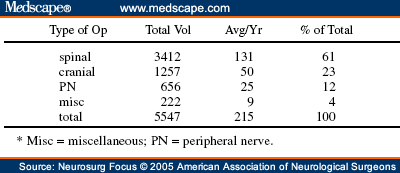What do neurosurgeons actually do? A statistical analysis of one neurosurgeon’s entire career
Neurosurgical Focus
October 2005 / Vol. 19 / No. 4 / Pages 1-5
READO MORE: http://www.medscape.com/viewarticle/515636_3
The author maintained prospective records on every patient he treated during the 26 years of his neurosurgical private practice.
….
In my 26 years of practice, I performed 5578 neurosurgical operations in 14,391 patients for a “surgical rate” of 39%. This does not include lumbar punctures, shunt taps, Ommaya reservoir injections, or myelograms, but it does include carpal tunnel surgery, tracheostomies, and repair of major lacerations. The frequency and volume of surgery fluctuated somewhat over the years, but saw a modest rise when I assumed a full role in my second clinic, perhaps because of its relative isolation and distance from competing metropolitan areas and university medical centers.
These numbers correspond to a yearly rate of approximately 587 consultations and 215 operations. Pediatric (patient < 16 years old) consultations comprised 6% of the total patients and infants (patient < 1 year old) comprised 1% of cases. The number of younger patients diminished over the years as more and more elective cases were referred to metropolitan and/or academic centers.
In this analysis, spinal surgery comprised 61% of the operative workload, with cranial procedures totaling 23%, peripheral nerve surgery 12%, and miscellaneous surgery 4%. Among the spinal procedures, 66% were lumbosacral, 32% were cervical, and only 2% were thoracic ( Table 2 ). The most common operation was a lumbar laminectomy and decompression, typically for spondylosis ( Table 3 ). Anterior cervical fusions were frequent and usually of the classic Cloward type, with my preference being autologous bone grafting. In recent years I had used anterior cervical plates, but not on a routine basis; I usually reserved this technique for fractures or multilevel procedures. Lumbar laminotomies for disc resection comprised the third-most common type of operation.
…
READO MORE: http://www.medscape.com/viewarticle/515636_3

